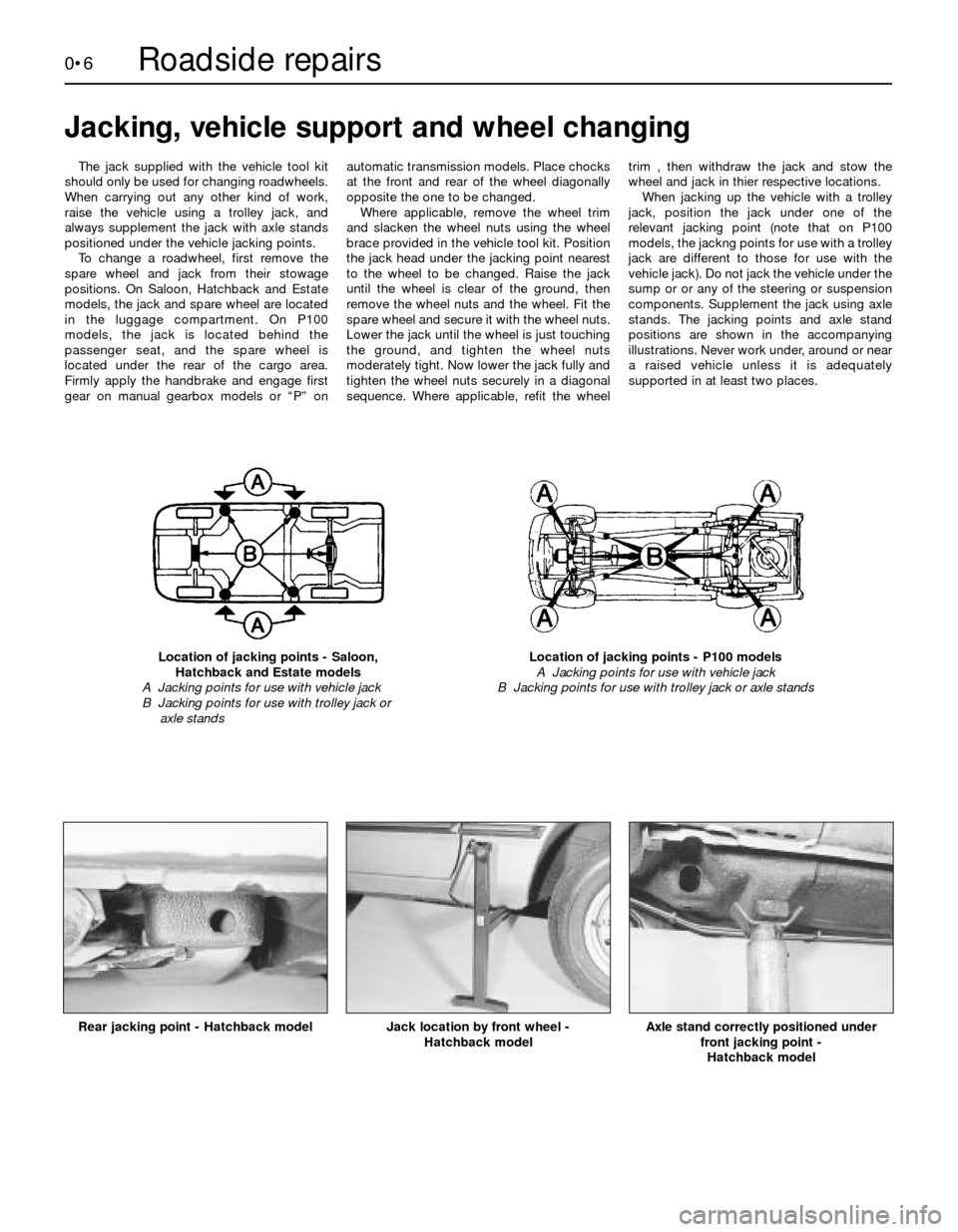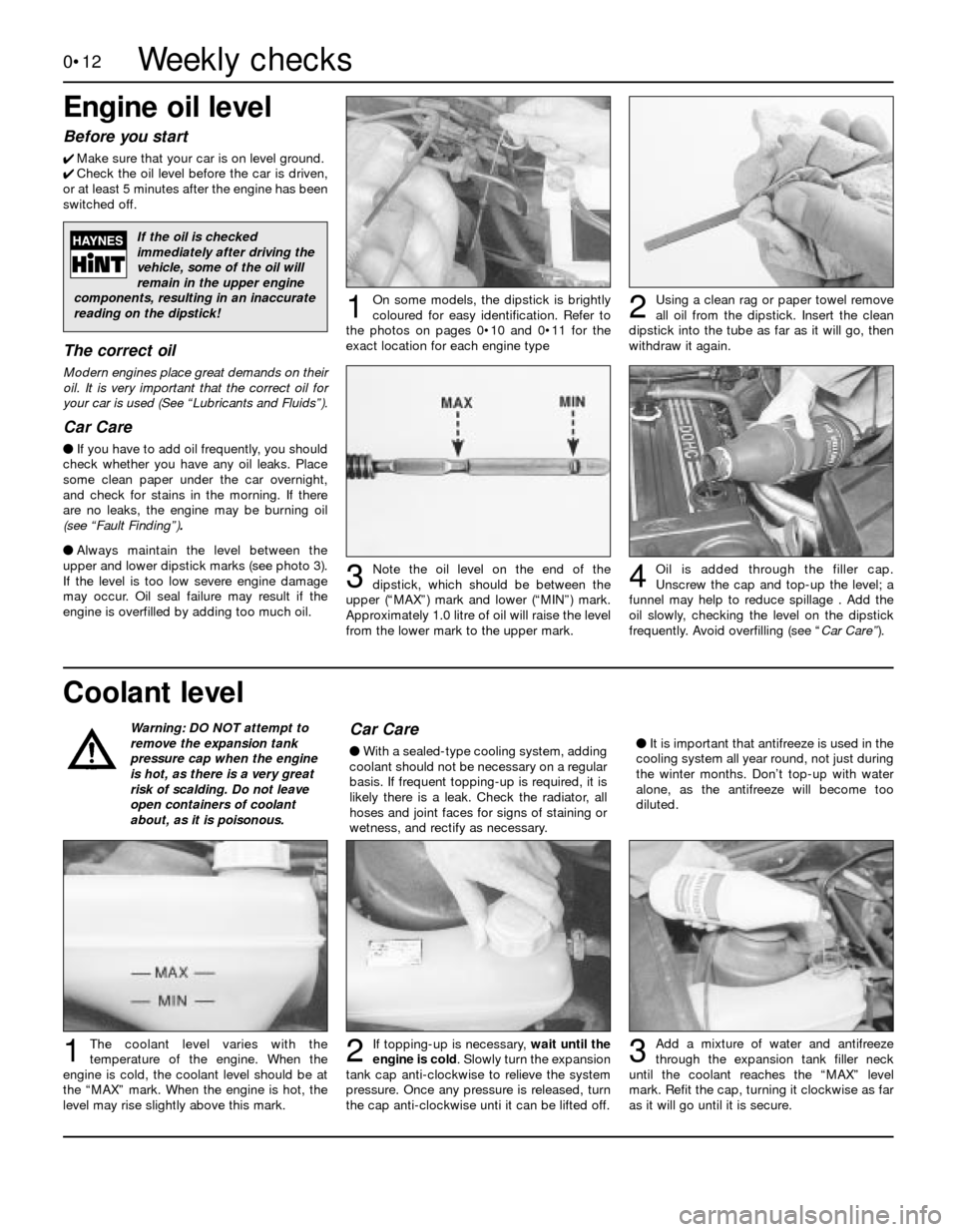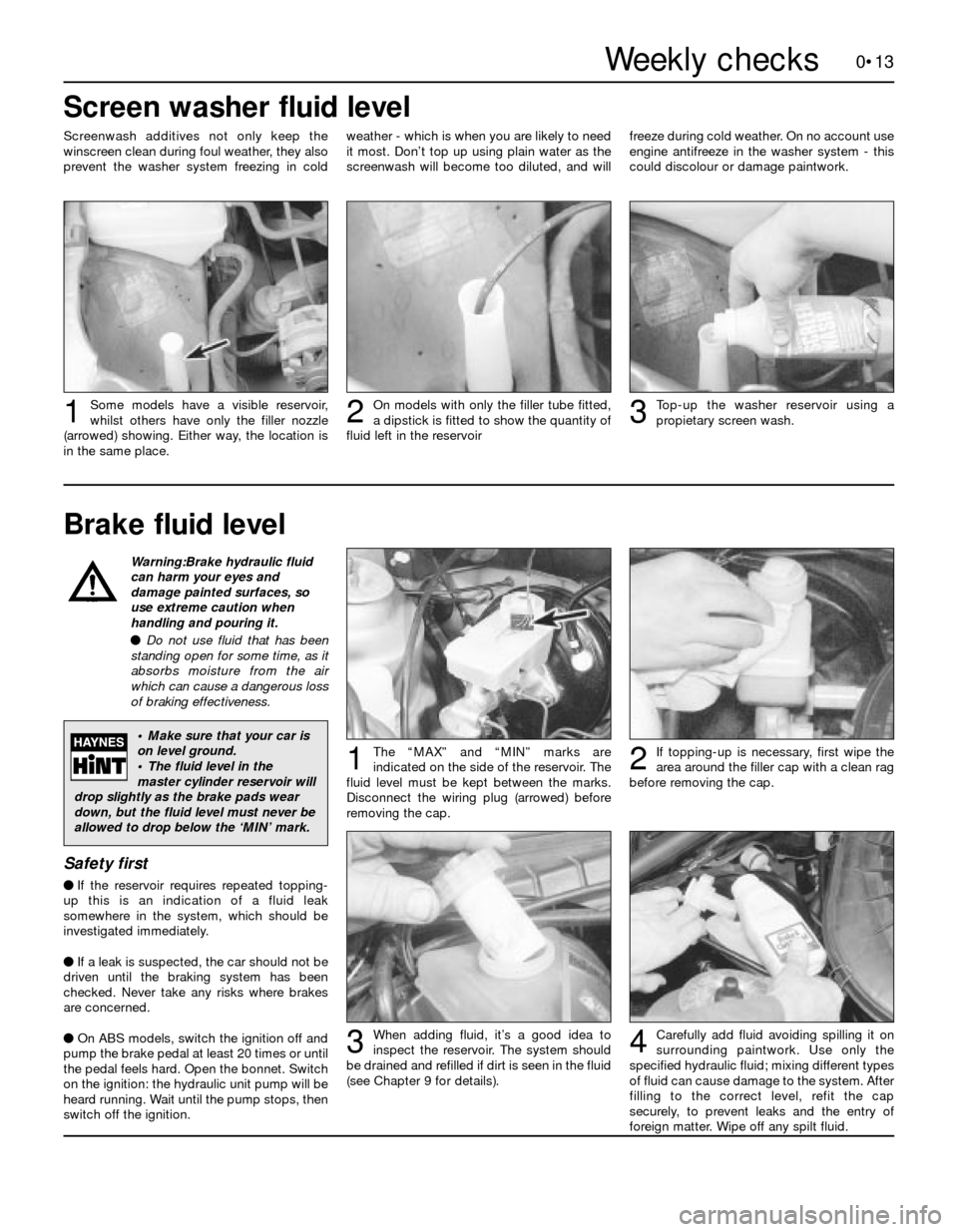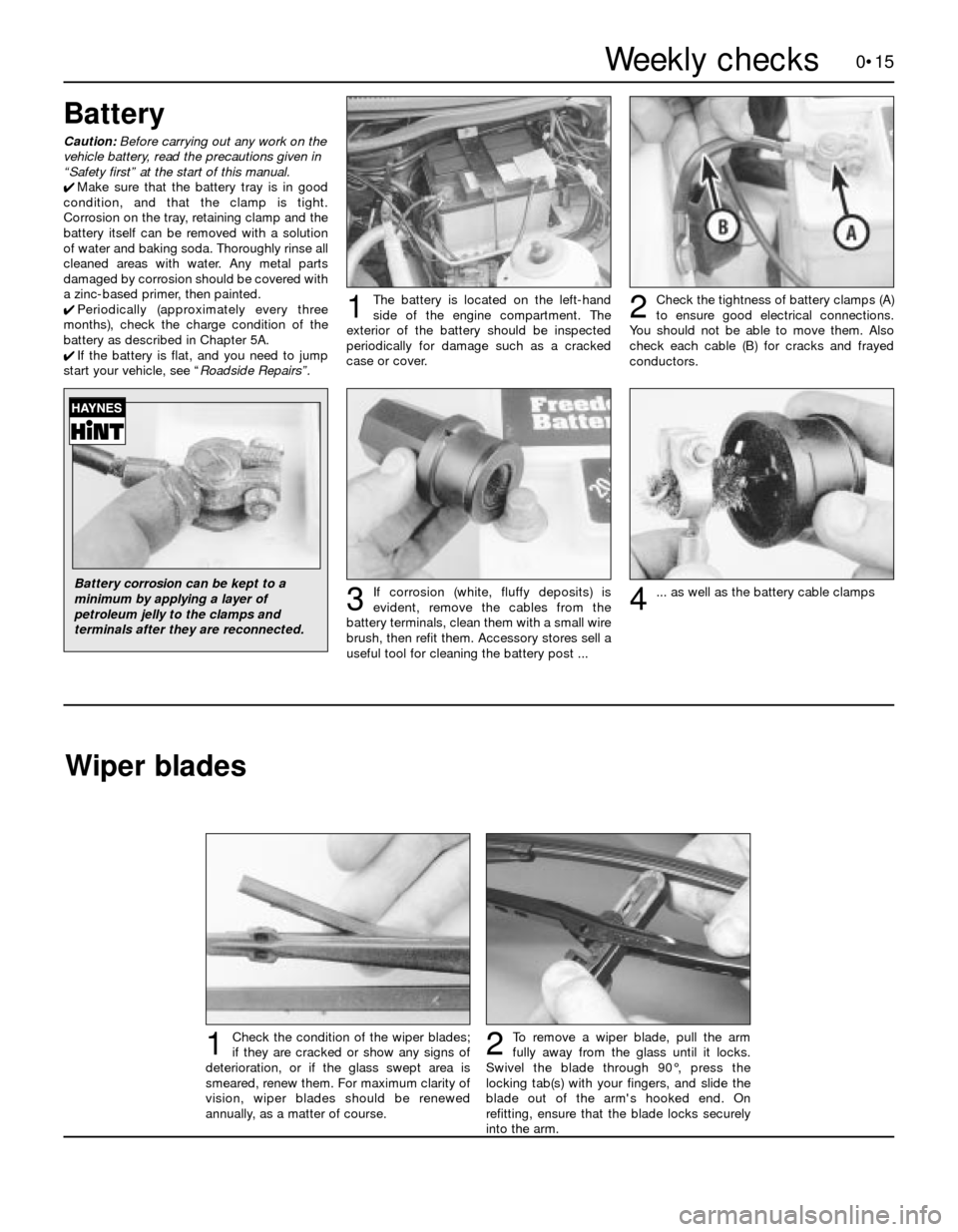ECU FORD SIERRA 1983 1.G Introduction Workshop Manual
[x] Cancel search | Manufacturer: FORD, Model Year: 1983, Model line: SIERRA, Model: FORD SIERRA 1983 1.GPages: 18, PDF Size: 0.5 MB
Page 6 of 18

0•6
The jack supplied with the vehicle tool kit
should only be used for changing roadwheels.
When carrying out any other kind of work,
raise the vehicle using a trolley jack, and
always supplement the jack with axle stands
positioned under the vehicle jacking points.
To change a roadwheel, first remove the
spare wheel and jack from their stowage
positions. On Saloon, Hatchback and Estate
models, the jack and spare wheel are located
in the luggage compartment. On P100
models, the jack is located behind the
passenger seat, and the spare wheel is
located under the rear of the cargo area.
Firmly apply the handbrake and engage first
gear on manual gearbox models or “P” onautomatic transmission models. Place chocks
at the front and rear of the wheel diagonally
opposite the one to be changed.
Where applicable, remove the wheel trim
and slacken the wheel nuts using the wheel
brace provided in the vehicle tool kit. Position
the jack head under the jacking point nearest
to the wheel to be changed. Raise the jack
until the wheel is clear of the ground, then
remove the wheel nuts and the wheel. Fit the
spare wheel and secure it with the wheel nuts.
Lower the jack until the wheel is just touching
the ground, and tighten the wheel nuts
moderately tight. Now lower the jack fully and
tighten the wheel nuts securely in a diagonal
sequence. Where applicable, refit the wheeltrim , then withdraw the jack and stow the
wheel and jack in thier respective locations.
When jacking up the vehicle with a trolley
jack, position the jack under one of the
relevant jacking point (note that on P100
models, the jackng points for use with a trolley
jack are different to those for use with the
vehicle jack). Do not jack the vehicle under the
sump or or any of the steering or suspension
components. Supplement the jack using axle
stands. The jacking points and axle stand
positions are shown in the accompanying
illustrations. Never work under, around or near
a raised vehicle unless it is adequately
supported in at least two places.
Jacking, vehicle support and wheel changing
Location of jacking points - Saloon,
Hatchback and Estate models
A Jacking points for use with vehicle jack
B Jacking points for use with trolley jack or
axle standsLocation of jacking points - P100 models
A Jacking points for use with vehicle jack
B Jacking points for use with trolley jack or axle stands
Rear jacking point - Hatchback model
Jack location by front wheel -
Hatchback modelAxle stand correctly positioned under
front jacking point -
Hatchback model
Roadside repairs
Page 12 of 18

Coolant level Engine oil level
Before you start
4Make sure that your car is on level ground.
4Check the oil level before the car is driven,
or at least 5 minutes after the engine has been
switched off.
The correct oil
Modern engines place great demands on their
oil. It is very important that the correct oil for
your car is used (See “Lubricants and Fluids”).
Car Care
l If you have to add oil frequently, you should
check whether you have any oil leaks. Place
some clean paper under the car overnight,
and check for stains in the morning. If there
are no leaks, the engine may be burning oil
(see “Fault Finding”).
lAlways maintain the level between the
upper and lower dipstick marks (see photo 3).
If the level is too low severe engine damage
may occur. Oil seal failure may result if the
engine is overfilled by adding too much oil.
0•12
Using a clean rag or paper towel remove
all oil from the dipstick. Insert the clean
dipstick into the tube as far as it will go, then
withdraw it again.
Add a mixture of water and antifreeze
through the expansion tank filler neck
until the coolant reaches the “MAX” level
mark. Refit the cap, turning it clockwise as far
as it will go until it is secure.
If topping-up is necessary, wait until the
engine is cold. Slowly turn the expansion
tank cap anti-clockwise to relieve the system
pressure. Once any pressure is released, turn
the cap anti-clockwise unti it can be lifted off.The coolant level varies with the
temperature of the engine. When the
engine is cold, the coolant level should be at
the “MAX” mark. When the engine is hot, the
level may rise slightly above this mark.
Note the oil level on the end of the
dipstick, which should be between the
upper (“MAX”) mark and lower (“MIN”) mark.
Approximately 1.0 litre of oil will raise the level
from the lower mark to the upper mark.Oil is added through the filler cap.
Unscrew the cap and top-up the level; a
funnel may help to reduce spillage . Add the
oil slowly, checking the level on the dipstick
frequently. Avoid overfilling (see “Car Care”).
On some models, the dipstick is brightly
coloured for easy identification. Refer to
the photos on pages 0•10 and 0•11 for the
exact location for each engine type12
3
123
4
Warning: DO NOT attempt to
remove the expansion tank
pressure cap when the engine
is hot, as there is a very great
risk of scalding. Do not leave
open containers of coolant
about, as it is poisonous.Car Care
lWith a sealed-type cooling system, adding
coolant should not be necessary on a regular
basis. If frequent topping-up is required, it is
likely there is a leak. Check the radiator, all
hoses and joint faces for signs of staining or
wetness, and rectify as necessary.lIt is important that antifreeze is used in the
cooling system all year round, not just during
the winter months. Don’t top-up with water
alone, as the antifreeze will become too
diluted.
If the oil is checked
immediately after driving the
vehicle, some of the oil will
remain in the upper engine
components, resulting in an inaccurate
reading on the dipstick!
Weekly checks
Page 13 of 18

Warning:Brake hydraulic fluid
can harm your eyes and
damage painted surfaces, so
use extreme caution when
handling and pouring it.
l Do not use fluid that has been
standing open for some time, as it
absorbs moisture from the air
which can cause a dangerous loss
of braking effectiveness.
Safety first
lIf the reservoir requires repeated topping-
up this is an indication of a fluid leak
somewhere in the system, which should be
investigated immediately.
lIf a leak is suspected, the car should not be
driven until the braking system has been
checked. Never take any risks where brakes
are concerned.
lOn ABS models, switch the ignition off and
pump the brake pedal at least 20 times or until
the pedal feels hard. Open the bonnet. Switch
on the ignition: the hydraulic unit pump will be
heard running. Wait until the pump stops, then
switch off the ignition.
Brake fluid level
0•13
Carefully add fluid avoiding spilling it on
surrounding paintwork. Use only the
specified hydraulic fluid; mixing different types
of fluid can cause damage to the system. After
filling to the correct level, refit the cap
securely, to prevent leaks and the entry of
foreign matter. Wipe off any spilt fluid.When adding fluid, it’s a good idea to
inspect the reservoir. The system should
be drained and refilled if dirt is seen in the fluid
(see Chapter 9 for details).
The “MAX” and “MIN” marks are
indicated on the side of the reservoir. The
fluid level must be kept between the marks.
Disconnect the wiring plug (arrowed) before
removing the cap.1If topping-up is necessary, first wipe the
area around the filler cap with a clean rag
before removing the cap.2
34
Screen washer fluid level
Some models have a visible reservoir,
whilst others have only the filler nozzle
(arrowed) showing. Either way, the location is
in the same place.Top-up the washer reservoir using a
propietary screen wash.On models with only the filler tube fitted,
a dipstick is fitted to show the quantity of
fluid left in the reservoir
Screenwash additives not only keep the
winscreen clean during foul weather, they also
prevent the washer system freezing in coldweather - which is when you are likely to need
it most. Don’t top up using plain water as the
screenwash will become too diluted, and willfreeze during cold weather. On no account use
engine antifreeze in the washer system - this
could discolour or damage paintwork.
123
• Make sure that your car is
on level ground.
• The fluid level in the
master cylinder reservoir will
drop slightly as the brake pads wear
down, but the fluid level must never be
allowed to drop below the ‘MIN’ mark.
Weekly checks
Page 14 of 18

0•14
Before you start:
4Park the vehicle on level ground.
4Set the steering wheel pointing straight-
ahead.
4The system should be at operating
temperature and the engine should be
turned off.
Safety First:
lThe need for frequent topping-up indicates
a leak, which should be investigated
immediately.
Top-up if necessary with clean fluid of
the specified typeIf the level is checked
cold, use the “MIN” or “FULL COLD” mark.
Recheck the level at operating temperature.
The fluid level should be up to the
“MAX” or upper “HOT” markThe power steering fluid reservoir is
located next to the coolant expansion
tank. Clean around the filler cap and then
remove it should topping up be required.123
For the check to be accurate
the steering must not be
turned once the engine has
been stopped.
Power steering fluid level
Weekly checks
Electrical system
To replace a blown fuse, simply pull it out.
Fit a new fuse of the same rating,
available from car accessory shops.
It is important that you find the reason that the
fuse blew - a checking procedure is given in
Chapter 13.If more than one indicator light or
headlight has failed it is likely that either a
fuse has blown or that there is a fault in the
circuit (refer to“Electrical fault-finding”in
Chapter 13).
The fuses are mounted in a box in the engine
compartment on the right-hand side of the
bulkhead. Remove the loose cover (and spring
clip if fitted), pulling the plastic clip, and
removing the plastic cover.If a single indicator light, brake light or
headlight has failed it is likely that a bulb
has blown and will need to be replaced. Refer
to Chapter 12 for details.
If both brake lights have failed, it is possible
that the brake light switch above the brake
pedal needs adjusting. This simple operation
is described in Chapter 9.1
If you need to check your
brake lights and indicators
unaided, back up to a wall
or garage door and operate
the lights. The reflected light should
show if they are working properly.
4Check all external lights and the horn. Refer
to the appropriate Sections of Chapter 13 for
details if any of the circuits are found to be
inoperative.4Visually check all wiring connectors,
harnesses and retaining clips for security, and
for signs of chafing or damage.
23
Page 15 of 18

0•15
To remove a wiper blade, pull the arm
fully away from the glass until it locks.
Swivel the blade through 90°, press the
locking tab(s) with your fingers, and slide the
blade out of the arm's hooked end. On
refitting, ensure that the blade locks securely
into the arm.Check the condition of the wiper blades;
if they are cracked or show any signs of
deterioration, or if the glass swept area is
smeared, renew them. For maximum clarity of
vision, wiper blades should be renewed
annually, as a matter of course.21Weekly checks
Battery
Caution:Before carrying out any work on the
vehicle battery, read the precautions given in
“Safety first” at the start of this manual.
4Make sure that the battery tray is in good
condition, and that the clamp is tight.
Corrosion on the tray, retaining clamp and the
battery itself can be removed with a solution
of water and baking soda. Thoroughly rinse all
cleaned areas with water. Any metal parts
damaged by corrosion should be covered with
a zinc-based primer, then painted.
4Periodically (approximately every three
months), check the charge condition of the
battery as described in Chapter 5A.
4If the battery is flat, and you need to jump
start your vehicle, see “Roadside Repairs”.The battery is located on the left-hand
side of the engine compartment. The
exterior of the battery should be inspected
periodically for damage such as a cracked
case or cover.
Check the tightness of battery clamps (A)
to ensure good electrical connections.
You should not be able to move them. Also
check each cable (B) for cracks and frayed
conductors.
If corrosion (white, fluffy deposits) is
evident, remove the cables from the
battery terminals, clean them with a small wire
brush, then refit them. Accessory stores sell a
useful tool for cleaning the battery post ...
12
3... as well as the battery cable clamps4
Battery corrosion can be kept to a
minimum by applying a layer of
petroleum jelly to the clamps and
terminals after they are reconnected.
Wiper blades